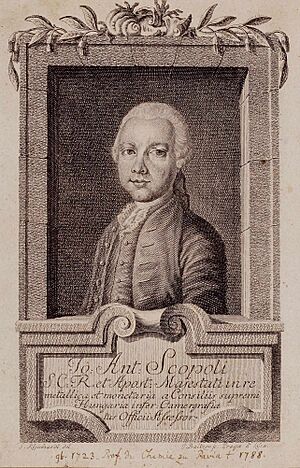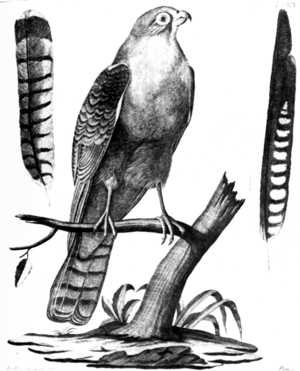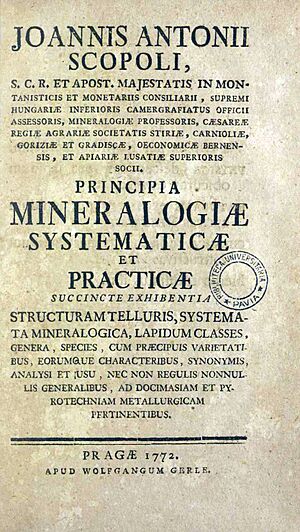Giovanni Antonio Scopoli facts for kids
Quick facts for kids
Giovanni Antonio Scopoli
|
|
|---|---|

Giovanni Antonio Scopoli
|
|
| Born | 3 June 1723 Cavalese, Val di Fiemme
|
| Died | 8 May 1788 (aged 64) |
| Nationality | Prince-Bishopric of Trent |
| Occupation | plant scientist, pteridologist, chemist, zoologist, ornithologist, physician, biologist, lepidopterologist, arachnologist, mycologist, earth scientist, university professor |
| Scientific career | |
| Fields | |
Giovanni Antonio Scopoli (born June 3, 1723 – died May 8, 1788) was an Italian physician and naturalist. He was a very important scientist, sometimes called the "Linnaeus of the Austrian Empire". This means he was as influential in his region as Carl Linnaeus was worldwide for naming living things.
Contents
Who Was Giovanni Antonio Scopoli?
Giovanni Antonio Scopoli was born in Cavalese, a town in what is now Trentino, Italy. His father was a military officer, and his mother was a painter. He studied medicine at the University of Innsbruck and worked as a doctor in Cavalese and Venice. He spent a lot of his free time exploring the Alps. There, he collected many different plants and insects, building amazing collections.
Scopoli's Work in Idrija
In 1754, Scopoli became a doctor for the mercury mines in Idrija. This was a small town in the Habsburg Empire. He stayed there for 15 years. In 1761, he wrote a book called De Hydroargyro Idriensi Tentamina. This book described the health problems that miners faced from mercury poisoning.
While in Idrija, Scopoli also studied the local plants and animals. He published Flora Carniolica in 1760, which was about the plants of the Carniola region. He also wrote a big book about insects called Entomologia Carniolica in 1763. From 1769 to 1772, he published a series of books called Anni Historico-Naturales. These books included the first descriptions of many birds he had studied.
Later Life and Legacy
In 1769, Scopoli became a professor of chemistry and metal studies at the Mining Academy in Schemnitz (now Banská Štiavnica, Slovakia). Later, in 1777, he moved to the University of Pavia in Italy.
He became a rival of another famous scientist, Lazzaro Spallanzani. There was a disagreement between them, but Spallanzani was cleared of any wrongdoing. Soon after, Scopoli passed away from a stroke. His last major work was Deliciae Flora et Fauna Insubricae (1786–1788). This book gave scientific names to birds and mammals found in northwestern Italy. These animals had been described by Pierre Sonnerat during his travels.
Scopoli regularly wrote letters to Carl Linnaeus, the Swedish botanist who created the modern system for classifying living things. Scopoli shared all his discoveries and descriptions with Linnaeus. For example, he told Linnaeus about the olm and the dormouse, which Linnaeus had not known about before. Linnaeus respected Scopoli's work very much. Even though they never met in person, they had a strong scientific connection.
Important Books by Scopoli
Scopoli wrote many important books that helped us understand the natural world.
- Flora Carniolica (1760): This book describes the plants of Carniola, a region that is now part of Slovenia. A second, updated edition was published later. It included scientific names for plants, following Linnaeus's system.
- De Hydroargyro Idriensi Tentamina (1761): This medical book focused on the health problems caused by mercury poisoning in miners.
- Entomologia Carniolica (1763): This was a very important book about entomology (the study of insects). It described many new insect species.
- Anni Historico-Naturales (1769–1772): This series of books included descriptions of new bird species.
- Introductio ad historiam naturalem (1777): This was a major work on natural history. It described many types of rocks, plants, and animals known at the time.
- Deliciae Flora et Fauna Insubricae (1786–1788): This book included new descriptions of birds and mammals.
Animals and Plants Named by Scopoli
Giovanni Antonio Scopoli named many different species of animals and plants. Here are just a few examples:
- Anser albifrons (1769) – the Greater White-fronted Goose
- Tyto alba (1769) – the Western Barn Owl
- Athene noctua (1769) – the Little Owl
- Psittacula krameri (1769) – the Rose-ringed Parakeet
- Emerita (1777) – a genus of mole crabs
- Battus (1777) – a genus of swallowtail butterflies
- Bombus pascuorum (1763) – a type of bumblebee
- Amanita caesarea (1772) – the Caesar's mushroom, which is edible and highly valued.
- Laccaria laccata (1772) – the deceiver mushroom
Things Named After Scopoli
Other scientists have named things in honor of Giovanni Antonio Scopoli because of his great contributions to science.
- Scopolia: This is a genus (group) of plants. The medicine scopolamine comes from these plants.
- Scopolia: This is a genus of moths.
- Cerambyx scopolii (1775): This is a type of longhorn beetle found in Europe.
- Dorcadion scopolii (1784): Another type of longhorn beetle found in Europe.
- Scops owl: A type of owl.
See also
 In Spanish: Giovanni Antonio Scopoli para niños
In Spanish: Giovanni Antonio Scopoli para niños



